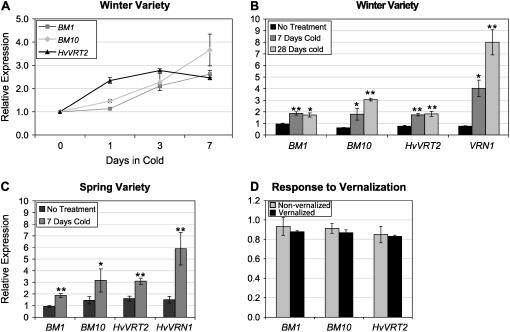Figure 4.
BM1, BM10, and HvVRT2 are induced by cold. A, Relative expression levels of BM1, BM10, and HvVRT2, assayed by qRT-PCR, in a winter variety (cv Sonja, minus roots) after 0, 1, 3, or 7 d cold treatment (4°C). Expression is shown relative to the initial time point (14-d-old plants grown in standard glasshouse conditions). B, Relative expression levels of BM1, BM10, HvVRT2, and HvVRN1, assayed by qRT-PCR, in a winter barley variety (cv Sonja, minus roots) maintained in normal glasshouse conditions for 7 d (no treatment) or after 7 or 28 d of cold treatment. Expression is shown relative to the initial time point (14-d-old plants in standard glasshouse conditions). C, Expression levels of BM1, BM10, HvVRT2, and HvVRN1, assayed by qRT-PCR, in plants of a spring barley cultivar (cv Golden Promise, minus roots) that were maintained in normal glasshouse conditions (no treatment) or shifted to cold conditions (4°C) for 7 d. Expression is shown relative to the initial time point (14-d-old plants in normal glasshouse temperatures). Error bars show se. D, Expression levels of BM1, BM10, and HvVRT2 assayed by qRT-PCR in plants (cv Sonja, minus roots) that were imbibed and vernalized for 9 weeks then reacclimatized to standard glasshouse conditions for a week. Expression is shown relative to control nonvernalized plants at the same developmental stage (two leaves, vegetative shoot apex). Differences were nonsignificant by Student's t test. Error bars show se. Asterisks indicate P values of Student's t tests: *, P < 0.05; **, P < 0.01.

